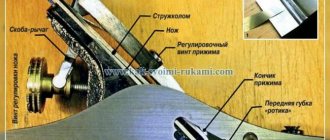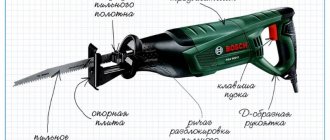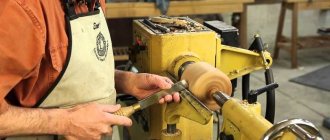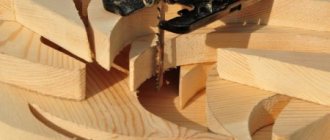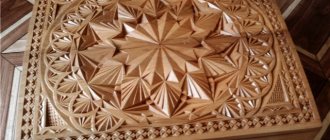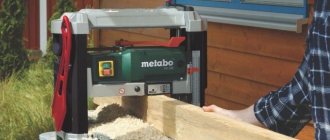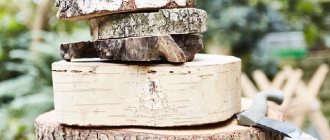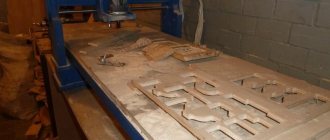Types of grinding machines
How can you choose from the wide variety of sanding machines, because all the tools use the same abrasive material - sandpaper, but the results are different. This happens because different models have their own strengths and weaknesses.
Some grinders are needed for rough sanding, while others are better at polishing the surface. Those machines that are not designed to work on large areas are good for spot work in hard to reach areas.
You need to understand what types of work the tool will be used for, for general leveling of the surface or for finishing grinding, because in both cases you will need different tools.
Belt sander
The belt sander (abbreviated as LSM) gets its name because of its operating principle, in which the sanding pad, in the form of a ring, moves continuously using built-in rollers around the soleplate.
A wood grinder can be used for rough grinding - in preparation before finer processing. This sander is the most productive compared to other models. It can handle a lot of rough sanding, but it is not recommended for finishing.
It is used when carrying out woodworking work that is not intended for further painting, so that subsequent finishing sanding with another tool will take less time. When installing sandpaper with fine grain, you can achieve average quality of material processing.
It is good to use such a machine close to the wall, but only with one side edge.
Disadvantages of a tape machine:
- During operation, the machine leaves a lot of scratches, the number of which can be reduced if you sand along the grain of the wood.
- If used carelessly, it can create a hole in the surface of the material, which will be difficult to remove.
- Due to the design, it is impossible to reach hard-to-reach places such as corners and grooves.
- It makes a lot of noise during operation, so it requires special headphones.
- The roller action means the belt is raised in front and behind, so sanding occurs only in the center of the abrasive belt.
- Difficult to clean vertical surfaces.
Surface grinder
A surface grinder is also called a vibratory or vibratory grinder. It can be used for finishing work before painting or varnishing. It is suitable for sanding large surfaces, but its performance is lower compared to the belt model, but it produces much less noise.
metabo surface grinder
ferm surface grinder
The platform of this model has a rectangular shape and is equipped with spring clamps for attaching sandpaper. There may be Velcro on the bottom to better hold the skin, but not all models have it. To remove dust while working on the platform, there are holes connected to the terminal for connecting a vacuum cleaner or a dust collection container.
It works due to small circular vibration movements performed with high frequency by its lower working surface - the grinding platform. The eccentricity (oscillation amplitude, platform stroke) of the platform movements averages from 2 to 5 millimeters. For small, square models it can be 1.5 mm. The vibration frequency of the platform varies greatly depending on the model, with an average of 12,000 rpm. It’s good if frequency adjustment is provided.
Stroke of the surface grinder platform
This model has a significant drawback - when sanding, it can leave round marks - “lambs” if a grain of sand or other debris gets between the sandpaper and the surface during sanding. This defect occurs due to insufficient dust removal, and is eliminated with finer-grain sandpaper in several iterations. Therefore, the surface is thoroughly cleaned first and a construction vacuum cleaner is used to immediately remove all foreign elements.
Traces of debris that got under the sander sole
The grinding area is limited; with models with a platform stroke of more than 2 mm, it is difficult to perform high-quality grinding close to the walls - in the inner corners, at a distance of approximately 4-8 mm to the surface perpendicular to the grinded surface. She will simply hit the wall with her sole and this can ruin the product.
Random orbital sander
An eccentric sander is also called an orbital sander. It has a round sole to which sandpaper is attached with Velcro. There are holes on the base of the orbital machine that allow dust to enter during sanding. Dust accumulates in a special dust container and must be cleaned periodically. Instead of a dust collector, you can connect a construction vacuum cleaner.
This grinder is slightly less productive than a surface grinder, but when working on wood it is more difficult to damage the material, because Due to the free rotation of the sole, traces of debris under the sandpaper are not so noticeable. Those. the quality of its processing will be higher than that of the previous model.
General positive characteristics:
- Light weight.
- Doesn't make much noise.
- Good speed.
- The machine is easy to control.
- Grinding is carried out at different levels.
But due to its shape, the device is not able to process the surface in the corners, and also has a weak impact zone along the edges.
Looking at the shape of the sole, you might think that grinding is done by rotating it, but this is a misconception. This grinding machine works on the same principle as a surface grinder - due to vibration. But its sole is not rigidly fixed and can rotate freely around its axis.
Delta grinder
A delta grinder (abbreviated as DShM) belongs to vibration grinding machines, since it operates on the same principle - the platform makes oscillatory movements with a high frequency.
The differences from a surface grinder are the delta-shaped platform, reminiscent of an iron (hence the name), small size and reduced vibration amplitude of the platform.
Due to the shape and shorter stroke of the platform, DShMs are used for rough and fine grinding of small, hard-to-reach places, such as recesses, protrusions and corners.
This model is not recommended for large volumes of woodworking; belt and surface sanders are more suitable for this.
Brush sander
A brush sander is also called a brushing machine because... This tool is not intended for grinding, but for brushing. But there are also grinding rollers, on the surface of which sandpaper is attached.
Brushing is the process of removing soft fibers from the surface of wood, after which a clearly defined structure of the remaining hard fibers (growth rings and knots) remains. This process is also called artificial aging of wood.
Brushing a wooden board
Brushing a wooden board
Brushed parquet
There are several designs of brush machines. The first is considered a subtype of a belt sander; the only difference is that a brush moves on rollers, which performs surface treatment.
Porter cable restorer brushing machine
Porter cable restorer brushing machine in operation
makita brush sander
In the second case, the machine is structurally similar to a blogarka which has a casing with a brush and a handle. The brush can also be a separate attachment for the grinder.
metabo brush grinder
Brush sander far tools
This tool is suitable if you need:
- remove layers of rust, scale and other deposits;
- remove the old layer of paint;
- clean the surface of the wood;
- wood brushing.
An undeniable bonus of the model is its ability to process a large area in a short time. But this model has a narrow focus and it will be difficult for it to perform fine grinding.
Renovator
Renovator is different from previous models. It is not designed specifically for grinding, that is one of its functions. Therefore, this tool is called a multi-tool and multi-functional tool (abbreviated as MFI).
The principle of its operation is to convert the rotational movements of the engine into oscillatory movements of the nozzle. The nozzle does not rotate around its axis, but makes oscillatory movements with a consistent deviation clockwise and counterclockwise by 1.4 - 1.6 degrees from the average position. Oscillations occur with high frequency, due to which grinding occurs.
The principle of operation of the renovator
The effectiveness of grinding decreases from the edges to the center of the nozzle, so the tool must be constantly, evenly moved across the surface so that the cleaning occurs evenly.
Different attachments allow you to saw, trim metal, wood, tiles, stone, clean, and grind surfaces. The advantages of a renovator include:
- It operates with great precision and reaches hard-to-reach places, due to the shape of the nozzles.
- It is light in weight.
- Possibility of connection to a vacuum cleaner.
Usually they are used for restoration and finishing work due to the small amplitude of vibrations.
But there are also some disadvantages:
- loud noise during operation;
- not high performance;
- some models require frequent breaks.
What are these devices?
Hand grinders are compact and lightweight analogues of industrial designs. All of them process surfaces with an abrasive material - sandpaper. There are different options for using this material, and corresponding tools are made for each of them.
They have different designs designed to perform specific tasks:
- Stripping and stripping
- Grinding
- Polishing
Expert opinion
Kulikov Vladimir Sergeevich
Each of these procedures produces a surface with a certain degree of roughness. In addition, grinding, performed in different ways, allows you to work with planes or curved parts.
Accessories and attachments
The price of a manual grinder makes you think about the need to purchase it, and many try to make an analogue from an angle grinder, a drill, or a homemade device.
There are special attachments for both angle grinders and drills that allow you to grind wood.
Velcro disc for grinder
To sand wood with a grinder, use special wheels with Velcro for sandpaper.
When grinding, the grinder is moved in different directions with careful movements. The grinding wheel breaks due to a collision with a nail head or sudden movements. Using paper of different grain sizes, you can carry out rough and medium sanding of a wooden surface. At the same time, the work speed will be faster than with other grinding machines.
It will be difficult to complete finishing work because... She needs to work very carefully so as not to damage the product. The tool will constantly be pulled to the side and pulled out of your hands.
The nozzle does not have dust removal, which is why debris will constantly accumulate under the sandpaper and interfere with work, leave scratches, and reduce speed. The disc is cleaned by grinding the metal for several seconds. During this time, all adhering dust particles burn out.
Drill attachment
To adapt a drill for grinding work, you will need a special attachment, similar in design to the attachment for an angle grinder - a sanding plate. Often the nozzle comes complete with an adapter so that it can be installed both in the chuck of a drill or screwdriver, and on an angle grinder.
Working with a drill with such an attachment is very difficult, more difficult than with an angle grinder. She is constantly being driven, the drill is being pulled out of her hands in such a way that she can get injured or sprained. The disadvantages that were listed above in the chapter about the attachment for angle grinders are also relevant.
But, if there is no other choice, then it is better to find a grinding plate that has soft rubber between the sole and the mount, which will bend easily if the drill is not held level.
Grinding attachment for drill flexo fix
This floating effect of the nozzle will somewhat simplify the grinding process, but will not eliminate all the other disadvantages of this method.
Homemade sanders
If you wish, you can make your own belt-type grinder - a grinder. But this process is labor-intensive and traumatic, requiring skills in working with wood, metal, electricity, and welding skills will come in handy.
Stages of creating a homemade grinder:
- Find the necessary materials: metal scraps, springs, rollers, bearings, electric motor and wires.
- They make a solid base for attaching the device.
- Install a tabletop that is suitable in size.
- Parallel stands with an electric motor and a drum with a sanding belt tensioner are installed.
- The drums and electric motor are assembled and attached.
- Install the sanding belt.
How to choose a tool
First, you need to decide for what type and volume of work you will need a tool, whether it will be one-time work or whether the sander is needed for constant use in a workshop or production.
If this is a one-time job, after which the grinding machine will no longer be needed, and you have a drill, screwdriver or grinder at hand, then you should pay attention to the grinding attachments for these tools. If they are suitable for the job, then you will save your time and money.
When the work is periodic and its volume is not large, then you should pay attention to the renovator. This tool will not only be able to perform grinding, but will also be useful in the future, because... it is indispensable for rare, small work on wood, metal, even tiles in hard-to-reach places. In the household, it can replace a bunch of other tools.
Renovator with attachments
If the tool is needed in a workshop for permanent work, where both rough cleaning and finishing grinding are required, incl. in hard-to-reach places, you will need two or three tools at once:
- A combination of belt, eccentric and delta sander will be a serious blow to the budget, but can cover all needs at once. As a result, we get quick cleaning and quick finishing grinding, as well as processing of corners that were inaccessible to previous models.
- A combination of a surface sander and a delta sander will not be as effective for large volumes of preparatory work for rough stripping of wood, it will take more time.
- A combination of an eccentric sander and a delta sander will be even slower, but the sanding result will be better.
To perform rare carpentry work at home or in a barn or workshop, cheaper models of grinding machines are suitable. Household machines can be designed for limited, intermittent use.
You should think about assembling a homemade device only if you have your own workshop or barn, where you have all the necessary materials, as well as a place to install the tool. It will also take a lot of time, patience and understanding of what it is needed for.
Important Features
Characteristics you need to pay attention to when choosing:
- Power consumption, as performance depends on it. In this case, capacities are compared between models, and not between types of machines.
- Does the device have a built-in dust removal system on the sole, an outlet for connecting a vacuum cleaner. Without it, dust particles will interfere: spoil the surface of the product, become clogged with the abrasive, reducing work efficiency. The more holes on the sole, the better; they should be evenly spaced over its entire area.
- The longer the power cord, the better. The extension cord compensates for this shortcoming, but it is not very convenient to carry a box with a socket along a cord.
- The handles should fit comfortably in the hand; for this purpose, rubber pads are placed on them.
- All buttons should move to all positions without effort and lie on the handle so that you do not need to grab them to press them.
- Pay attention to the weight. The lightweight tool makes it easy to work vertically. Heavy models are easier to control.
- The presence of a “soft start” function - when the speed is gradually increased. The service life of the tool depends on it; it is also more pleasant when the tool starts working smoothly rather than jerkily.
- It should be possible to regulate the number of revolutions. For grinding, a large number of revolutions are used, but there are places where you need to carefully process the surface of the product at low speeds.
- The overheat protection function extends the life of the unit.
- For models with sandpaper clips, you need to check whether they are conveniently located and snap into place easily. Replacing the abrasive cloth should not be a problem.
Milling cutters for hand router
Milling cutters are cutting tools that process and shape a surface. They consist of a cylindrical part, which is clamped by collets in the unit holder, and a cutting part. The cylindrical part can be of different diameters. Choose one that has a collet for which your device has. The shape and placement of the knives of the cutting part determines the appearance of the wood after processing. Some cutters (for edges) have a stubborn roller. It specifies the distance from the cutting surface to the material being processed.
Working with a hand router on wood requires the presence of a certain number of cutters. This is a small part of what exists
Milling cutters are made from various metals and alloys. For processing soft wood species - pine, spruce, etc. - use ordinary nozzles (HSS), for hard species - oak, beech and others - from hard alloys (HM).
Any cutter has a certain resource and the highest speed at which normal work is ensured with the least runout. You should not exceed the recommended speed - this may cause the router to break down. There is also no point in sharpening a cutter if it is dull. This is done on special equipment (costing about 1000), where you can set the required sharpening angle. You won't be able to do anything manually. So dull ones are easier (and cheaper) to replace because they cost relatively little.
Selecting Sanding Paper
At different stages of sanding, as well as for different types of wood, it is necessary to use an abrasive cloth with different levels of grain size.
Sandpaper organizer
The grit of sandpaper, roughly speaking, can be considered the density of the grains - the number of particles of abrasive material spent on filling one square inch of surface.
The grit size can be determined by the markings on the back of the abrasive blade - this is the number indicated after the letter “P”. The higher the number, the finer the abrasive material and vice versa, the lower the number, the larger the grain.
Dependence of the type of work on the grain level:
- 22 - 36 - rough primary work;
- 40 - 60 - rough grinding;
- 80 - 120 - primary grinding;
- 150 - 180 - final grinding;
- 240 - 280 - grinding hard rocks;
- 400 - 600 - polishing;
- 1200 - 1500 - final polishing.
When working with wood, you cannot get by with sandpaper with one level of grit. If the board is sanded immediately after sawing, then you need to first go over it with P40, P80 blades for rough sanding. If the board is smooth enough, then you can immediately begin fine processing with blades P120, P240.
Sandpaper with different grits
Basically, this is enough to prepare the wood surface for painting or varnishing. But, if initially there is heavy contamination on the surface, an old rotten layer of wood, then it is better to start with P24 paper.
If it seems that the result after sanding P240 is not satisfactory, and you want a smoother surface, then you can sand it with P400 sandpaper. But no more, because Then polishing of the surface will begin, which may negatively affect the further process of priming and painting. Due to the fact that the surface will be perfectly smooth, adhesion will suffer, and the paint may then simply peel off.
Features, specifics of use
The main feature of hand-held wood sanders is their dependence on the type of abrasive. It is impossible to obtain a high quality surface using coarse sandpaper. The tool itself only creates the necessary conditions for the movement of the sandpaper, but it is the sandpaper that does the work. This property allows you to obtain high quality processing by consistently using material of different grain sizes - from coarse to the finest. The result is a smooth surface, which, if desired, can be brought to perfection.
Expert opinion
Kulikov Vladimir Sergeevich
Working with the tool requires some skill, attention and accuracy. It does not pose a serious danger, but a large amount of grinding dust requires effective removal. In addition, ventilation (at a minimum, airing) of the room where work is being carried out is necessary. The master himself must use a respirator and safety glasses.
Wood sanders have their own characteristics, as well as pros and cons.
We follow safety rules
Working with a grinding machine requires care and attention. If you do not take precautions, injuries may occur, so you must adhere to the following rules:
- Some models of grinders make a lot of noise during operation. Therefore, to protect your eardrums you need to wear special headphones.
- Even having a construction vacuum cleaner does not guarantee complete absence of dust. To protect the pulmonary tract from dust, wear a respirator or use a moistened, thick gauze bandage.
- To protect your eyes from dust and shavings, you need construction glasses.
- To avoid injury, you will need thick clothing and shoes that cover all parts of the body, and use mittens.
- Before emptying the dust container, the sander is disconnected from the power supply.
- The tool is turned off using a button before unplugging the plug from the socket.
